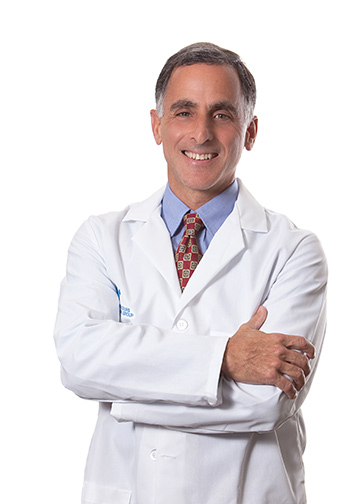 Dr. Anthony Terracina is a Board-certified surgeon specializing in laparoscopic bariatric surgery with the Bon Secours Surgical Weight Loss Center. He earned his medical doctorate degree at the University of Mississippi Medical Center in Jackson and completed his residency in general surgery at Parkland Hospital in Dallas, Texas.
Dr. Anthony Terracina is a Board-certified surgeon specializing in laparoscopic bariatric surgery with the Bon Secours Surgical Weight Loss Center. He earned his medical doctorate degree at the University of Mississippi Medical Center in Jackson and completed his residency in general surgery at Parkland Hospital in Dallas, Texas.
He is a member of the American College of Surgeons and the American Society of Bariatric Surgeons. He is currently Chief of Surgery and the Director of Bariatric Surgery at Mary Immaculate Hospital.
Dr. Terracina remembers the first gastric bypass he performed in 1999. “The patient told me his name was Capt. Hornblower. He played the trumpet in local jazz clubs. He was a severely obese 65-year-old man who was suffering from both diabetes and hypertension.” Dr. Terracina was honest: “I told him, ‘look, this is the first time I’ve performed this surgery.’ To which Hornblower replied, ‘Doc, look what I’ve done with my body my whole life. I need help.’”
Months after the surgery, Capt. Hornblower’s diabetes, hypertension and sleep apnea were resolved. “He said he wished he’d had the surgery 30 years ago,” Dr. Terracina says.
Since that first surgery, he has performed more than 3,400 bariatric procedures, including the three standard operations in use today: gastric bypass, sleeve gastrectomy and gastric banding. He’s still amazed at the number and variety of conditions that can be corrected by weight loss, including hypertension, reflux disease, polycystic ovarian syndrome, pseudotumor cerebrii, sleep apnea and several others. He also remembers one of his first patients reporting that six months after weight loss surgery, her glaucoma was gone. “I looked through the literature for any link between obesity and glaucoma, and found absolutely nothing,” he recalls, “but 13 years later, sure enough an article was published reporting glaucoma being cured by weight loss surgery. Obesity affects virtually every organ system in the body.”
In short, he says, “We know many conditions that are cured with weight loss, and there may be many more as well. There are things we don’t yet completely understand – like curing diabetes. There are many theories about why diabetes is cured almost instantaneously in eight out of ten patients. No one understands that perfectly – yet.”
The gastric bypass, Dr. Terracina explains, is one of the most studied operations in the world. “We really don’t know everything about how and why it works,” he says, “but there are four main mechanisms to help patients: portion control, hunger control, delayed digestion and aversion to sweets.”
“We think the gastric bypass is a near-perfect operation,” Dr. Terracina says. It’s often the procedure he uses when doing one of the complicated revisions that make up a large percentage of his practice. These revision surgeries include improving an outdated prior surgical procedure, or converting a previous procedure to a different one. Recently, he operated on a patient who had a vertical banded gastroplasty twenty-eight years ago. “She had a staple line failure, a typical result with one of these archaic surgeries. Her stomach looked as normal as the day she had her first surgery. I did a gastric bypass on her,” he says, “and she’ll do well as long as she continues with the follow-up that’s so important.”
What he particularly likes about his practice with the Bon Secours Surgical Weight Loss Center, Dr. Terracina says, is the fact that everyone who walks through the front door is a weight loss patient. “Our waiting room becomes a sort of impromptu support group: everyone’s either had or is having the surgery. There’s a built in camaraderie. They develop alliances and friendships. Our patients know that when they come to our office, everybody’s the same. There’s no judgment, just support and understanding.”
For patients in the super-obese category, finding a place where there is no judgment but plenty of understanding can be critical. “We see a tremendous population of the super obese,” Dr. Terracina says, “people who are well over 500 pounds. These patients aren’t always candidates for surgery due to the higher risk of their body size. But we can make them candidates in most situations.” He cites the example of a patient who presented last year at 540 pounds: “He was 5’10”. We first put him in our pre-op program, and he lost 80 pounds. We took him to the operating room and did a sleeve gastrectomy. He proceeded to lose more than 200 more pounds.”
Dr. Terracina knows that even the most successful weight loss patients can relapse. “About 15 to 20 percent of people will need to get back on track at some time in their lives,” he says. “And while we operate on people every day, the rest of the time, we’re listening to them. Due to stress and busy lives, they can resort to bad eating behaviors. I assure them they can get through those situations. Sometimes, I counsel as much as I operate.”
Dr. Terracina has a high percentage of patients who relocate from Hampton Roads after surgery, but they return every year to see him. They want that follow-up, he knows: “They want to come back in. If they did really well, they want that pat on the back. If it’s the opposite scenario, they want that ‘get back on track’ help.”
He insists, when his patients do well, that the credit ultimately belongs to them: “We perform the surgery and offer guidance. It’s the individual patient who makes the lifestyle changes and commitment to a healthier existence.”

